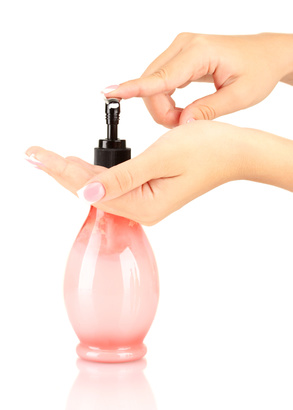Less than 2 weeks to speak up against triclosan!
May 17, 2012

The world has plenty of bogeymen and things that go bump in the night. To protect ourselves from things unseen, some people pack guns, others, well, they pack hand sanitizer. But while basic alcohol-fueled hand sanitizer is fairly harmless, especially if you get the organic kind from the health store (unless you consider the dry skin you get from alcohol gels a plague), the antibacterial chemical triclosan is now officially more of a villain than the bugs it’s trying to kill. You may have heard me rant about triclosan on your radio, in this blog or in my column before and I’m getting on my soapbox one more time because the clock is ticking! Friends, countrymen, we’ve got until May 30 to submit our comments to the feds on toxic triclosan so rally your pals and let the feds know you want triclosan banned altogether today. Here’s their email substances@ec.gc.ca. And here’s a sample letter:
To the Executive Director, Program Development and Engagement Division,
Thanks so much for taking the important first step of declaring triclosan officially toxic (Canada Gazette Vol. 1 146, No. 13-March 31, 2012). I agree that triclosan is a danger to the environment. However, if that’s the case, then triclosan should not continue to be sold on shelves. A voluntary phase-out isn’t enough. Please consider the request of the Canadian Medical Association and bring in a ban on triclosan in consumer products. The ingredient isn’t necessary in handsoap, toothpaste, deodorant or acne wash. It isn’t necessary in household items like pillow cases, underwear and cutting boards either, since triclosan is released into the environment ever time the products are washed. So one more time, pretty please with a cherry on top, reconsider your position and bring in a ban today.
By the way, you’ll notice that in the sample letter I only mentioned triclosan as an environmental hazard. That’s because Health Canada says it’s not a health hazard at the quantities to which we’re exposed. But come on now, what about the cumulative body burden of taking in triclosan from dozens of different products in our environment?? Environmental Defence’s new report Trouble with Triclosan spells out some of the potential health impacts, besides its potential for spawning antibiotic-resistant bugs:
Endocrine disrupting chemicals are substances that interfere with the body’s hormones. Triclosan is a known endocrine disruptor, and mimics thyroxine, an important hormone for the regulation of the body’s functions. Triclosan has also been shown to suppress the activity of mast cells, which are important to the functioning of the immune system. Initial studies of triclosan’s toxicity were based on a toxicology model that considers toxicity to be monotonic, meaning a higher dose is assumed to be more toxic, and research is aimed at assessing a safe dose, a threshold below which there will be no effect from exposure. But advances in the study of hormones have shown that chemicals like triclosan that mimic the body’s own hormones pose a risk to health even at low doses.
In light of advances in the study of hormone-mimicking chemicals and endocrine disruption, the argument that triclosan is safe in household products, at the low concentrations currently allowed, fails to take this into account. The established guidelines for use also fail to take into account that consumers are exposed to triclosan constantly, from numerous sources. Not only is the inclusion of triclosan in many of these products without proven benefit, triclosan’s endocrine-disrupting properties mean that the constant low-level exposure could be impacting our hormonal systems.
Couldn’t have said it better myself. Time to kiss triclosan goodbye for good. For the full breakdown of all the hidden sources of triclosan in household goods (from pillows to towels), check out my latest column.
